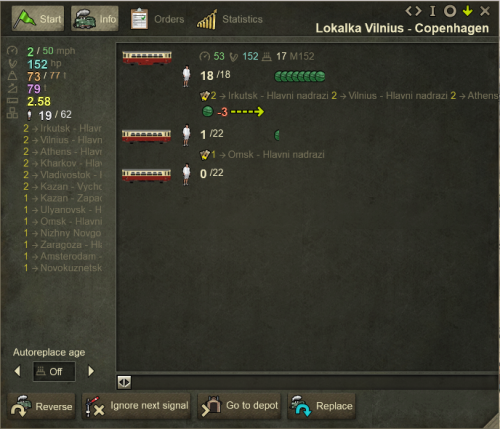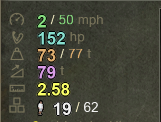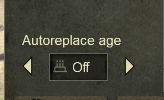Screenshot TBA
Trains are the main means of transportation in Mashinky, both because that is where the game's focus lie, and because trains have far greater capacity than other means of transportation (road vehicles). Players can use Trains to transport both Passengers and cargo from various industries. Each Train consists of at least one Engine and usually one or more Wagons. Trains are automatically given a numeric name based on the order you purchase the Engines, never reusing old numbers. Each Train's Orders are tied to the Train's lead Engine. Whenever you sell this Engine, the associated Train name and orders will disappear. Trains can be renamed freely. Trains are purchased in Depots.
Contents
Train Info Window Interface
Clicking on any train on the map will open the train info window:
Top row:
- Start/Stop button showing red or green flag - you can stop and start the train by clicking on this.
- Info tab: Information about the train (see below)
- Orders tab: Route list for the train (see Route Lists)
- Statistics tab: Shows the revenue and cost of the train in each year in service. Please note: this is unfinished feature in the game at the time of this page being created.
- Control Icons and Name of the Train (see this page for more details)
Bottom row:
- Reverse button: will cause the train to flip facing the other direction, or starting to move backwards depending on your preset of Magic Flip parameter
- Ignore next signal button: will cause the train to keep driving even if next signal is red. Use with extreme caution, might lead to crash.
- Go to depot button: will send the train to the nearest depot
- Replace button: will open replacement window interface
Train Stats
You can see all the important info about your train in this information/stat tab:
- The actual / maximum speed of the train
- The total horsepower of all the locomotives in the train
- The actual / fully loaded weight of the train
- The maximum weight the locomotives can pull without impediment
- The total length of the train (in squares of the map)
- The actual / total number of units and type of the cargo (for each cargo separately if train has more than one type of cargo)
Main Panel
More stats are next to the locomotive icon in the main panel:
![]()
The information is:
- Maximum speed of the train
- Total horsepower of the train
- Age of the locomotive
- Name of the locomotive
You can also see cargo load in each wagon in this panel and (for passenger and mail wagons) also the estimated income and list of the passenger/mail destinations
Autoreplace Feature
You can select the number of years after which the train will go automatically to the depot to be renewed and after renovation it will automatically return to its usual route. This is fairly new feature and if you load game saved from before this feature, it is set to OFF, and you need to change it manually for each train. The game remembers your most recent number and each newly purchased train later will have this value pre-selected. You can then leave it or freely change it.
Hint: Do not keep all trains servicing any one industry renewing after the same number of years, but rather spread it in an interval of 2-3 years apart. There are two reasons for that: * To not have the depot jammed by large number of trains renewing simultaneously * To not have any one industry completely without supplies during the time of "all" trains renewing
Multiple Units
There are many names (double-heading, push-pull, distributed power etc) for what amounts to the same thing: having more than one locomotive pull the train (at the head, at the end, or anywhere in between). As of this writing you are free to have as many engines you like in any given train with no limitations except one: every train must have an engine in the lead. In real-life, many factors limited the use of multiple units. In Mashinky however, they work together with no overhead costs or special issues.
Do keep in mind that the lead locomotive still carries the train's orders. That is, the first locomotive is more special than any others in the train. You will find that the game UI resists you if you try to use drag and drop to remove the lead engine from a train. Try this:
- Send your train to a depot
- Purchase a new (second) engine. It will appear on its own line, as its own train (with a new number).
- Drag this engine into the older train right behind the lead engine using your mouse. You will find you cannot directly place it in front. The newly minted train number disappears as the new engine is now considered part of the older train.
- Drag the existing (old) lead engine to a position further back in the train, so it is no longer the lead engine. Make sure an engine (your new engine) is the first unit (the game won't allow a wagon to lead a train). This engine now assumes the lead, and holds the train's orders.
- If you want you can now drag this old engine out of the train entirely (or just sell it in place).
Now you have successfully retained the train's orders but with a new engine in front.
Alternatively, you can use the game's dedicated UI for Renovation and Upgrade.
Train Vehicles
Operating Cost
- For more details, see Operating Costs.
Each train costs tokens to operate, based on its engine(s). Wagons have no operating costs. Most early engines cost simply money ![]() tokens. Later engines require coal
tokens. Later engines require coal ![]() , diesel
, diesel ![]() or energy
or energy ![]() tokens.
tokens.
The relation between industry production and fuel expenditure can be illustrated with an example:
If a base Factory is well supplied with Diesel ![]() it may produce 3 Diesel Tokens
it may produce 3 Diesel Tokens ![]() per game tick (actual output may vary, and can furthermore be increased by purchasing extensions). A diesel engine such as the fourth (diesel) era V220 is listed to have an operating cost of 1
per game tick (actual output may vary, and can furthermore be increased by purchasing extensions). A diesel engine such as the fourth (diesel) era V220 is listed to have an operating cost of 1 ![]() . What this means is that as long as the Factory is fully operational it enables you to run fifteen V220 engines without running out of diesel tokens.
. What this means is that as long as the Factory is fully operational it enables you to run fifteen V220 engines without running out of diesel tokens.
However, assuming Vehicle Aging has not been disabled, fuel consumption increases as the engines get older. After 50 years of service without renovation, just three V220s will consume the entire production of that Factory!
What this means is that should you decide to build a fleet of steam locomotives, you need to first make sure you are well supplied with ![]() (coal tokens) and the same goes for diesel and electric engines. The engines that run on money alone (such as the 2-6-0 Porter you start with, and the 60E in the Electric era) are the easiest to work with for beginner players. They do the job just as well, so strictly speaking you don't need engines that run on coal, diesel and energy; consider Mashinky offering them for variety!
(coal tokens) and the same goes for diesel and electric engines. The engines that run on money alone (such as the 2-6-0 Porter you start with, and the 60E in the Electric era) are the easiest to work with for beginner players. They do the job just as well, so strictly speaking you don't need engines that run on coal, diesel and energy; consider Mashinky offering them for variety!
Train Aging
The maintenance / fuel cost of a train depends not only on the type of the train but also on its age. Player has a choice to enable or disable the train aging feature in the main game setting before launching a new game. This setting CANNOT be changed for older saved game. You can also enable/disable fuel costs altogether separately (and even set it to a higher baseline cost).
Lets see all the details of Vehicle Aging and Game Settings.


